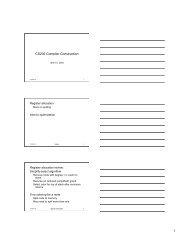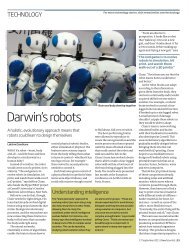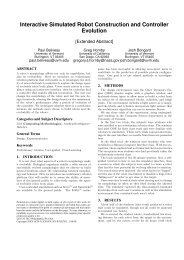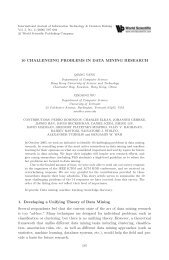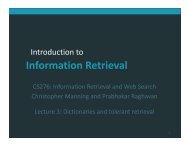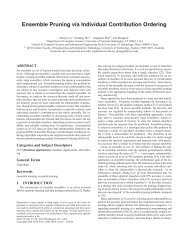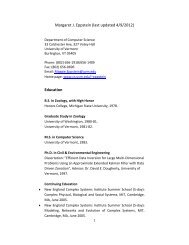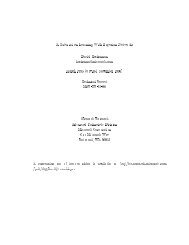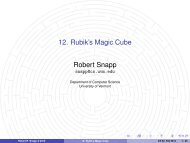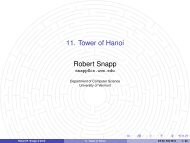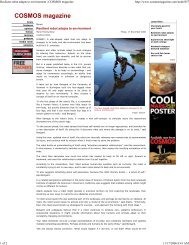Classical Logic in a Judgemental Style
Classical Logic in a Judgemental Style
Classical Logic in a Judgemental Style
Create successful ePaper yourself
Turn your PDF publications into a flip-book with our unique Google optimized e-Paper software.
<strong>Classical</strong> <strong>Logic</strong> <strong>in</strong> a <strong>Judgemental</strong> <strong>Style</strong><br />
Christian Skalka<br />
1 Propositional <strong>Logic</strong> Proof Theory<br />
We beg<strong>in</strong> with the syntax of classical logic formulae, and proof contexts. The set A of<br />
propositional symbols is countably <strong>in</strong>f<strong>in</strong>ite.<br />
P ∈ A<br />
propositional symbols<br />
φ ::= P | ¬φ | φ ∨ φ | φ ∧ φ | φ ⇒ φ well formed formulae (wffs)<br />
∆ ::= ∅ | ∆, φ contexts<br />
B<strong>in</strong>d<strong>in</strong>g strengths of operators: ¬ b<strong>in</strong>ds stronger than ⇒ b<strong>in</strong>ds stronger than ∧ b<strong>in</strong>ds<br />
stronger than ∨. Each of ¬, ∨, ⇒ are right-associative. We def<strong>in</strong>e the relation φ ∈ ∆<br />
<strong>in</strong>ductively as follows, allow<strong>in</strong>g lookup of a formula <strong>in</strong> a context.<br />
φ ∈ ∆, φ<br />
φ ∈ ∆<br />
φ ∈ ∆, φ ′<br />
Judgements are written ∆ ⊢ φ. Provability of a judgement is obta<strong>in</strong>ed by its f<strong>in</strong>ite<br />
derivation, given the follow<strong>in</strong>g set of natural deduction <strong>in</strong>ference rules. Note that each<br />
connective has an <strong>in</strong>troduction (I) and elim<strong>in</strong>ation (E) form. Intuitively, <strong>in</strong>troduction<br />
forms show how to build formulae, and elim<strong>in</strong>ation forms show how to use them.<br />
CONTEXT<br />
φ ∈ ∆<br />
∆ ⊢ φ<br />
∧-I<br />
∧-E 1<br />
∨-E 2<br />
∆ ⊢ φ 1 ∆ ⊢ φ 2 ∆ ⊢ φ 1 ∧ φ 2 ∆ ⊢ φ 1 ∧ φ 2<br />
∆ ⊢ φ 1 ∧ φ 2 ∆ ⊢ φ 1 ∆ ⊢ φ 2<br />
∨-I 1<br />
∆ ⊢ φ 1<br />
∆ ⊢ φ 1 ∨ φ 2<br />
∨-I 2<br />
∆ ⊢ φ 2<br />
∆ ⊢ φ 1 ∨ φ 2<br />
⇒-I<br />
∆, φ 1 ⊢ φ 2<br />
∆ ⊢ φ 1 ⇒ φ 2<br />
∨-E<br />
∆ ⊢ φ 1 ∨ φ 2 ∆, φ 1 ⊢ φ ∆, φ 2 ⊢ φ<br />
∆ ⊢ φ<br />
⇒-E<br />
∆ ⊢ φ 1 ⇒ φ 2 ∆ ⊢ φ 1<br />
∆ ⊢ φ 2<br />
¬-I<br />
∆, φ ⊢ P P does not occur <strong>in</strong> ∆, φ<br />
∆ ⊢ ¬φ<br />
¬-E<br />
∆ ⊢ φ ′ ∆ ⊢ ¬φ ′<br />
∆ ⊢ φ<br />
LEM<br />
∆ ⊢ φ ∨ ¬φ<br />
1
The exclusion of the rule LEM, commonly called law of the excluded middle, obta<strong>in</strong>s<br />
<strong>in</strong>tuitionistic or constructive logic. Formally, this is because it is the only rule form<br />
that allows an existentially bound proposition to be asserted without a witness of the<br />
existential be<strong>in</strong>g constructable (this is the fundamental requirement of constructivism).<br />
Consequently, <strong>in</strong>tuitionistic logic has a deep relation with computation (as ev<strong>in</strong>ced by<br />
e.g. the Curry Howard isomorphism).<br />
Def<strong>in</strong>ition 1 A context ∆ is <strong>in</strong>consistent iff ∆ ⊢ φ ∧ ¬φ is provable for some φ. A<br />
logic is <strong>in</strong>consistent if ∅ is <strong>in</strong>consistent.<br />
1.1 Derived Rules<br />
Some familiar pr<strong>in</strong>ciples that are derivable from the above, i.e. that do not add any<br />
more expressive power, <strong>in</strong>clude double negation elim<strong>in</strong>ation, rejected by <strong>in</strong>tuitionists<br />
and not derivable <strong>in</strong> <strong>in</strong>tuitionistic logic, but <strong>in</strong>ter-derivable with LEM:<br />
∆ ⊢ ¬¬φ<br />
∆ ⊢ φ<br />
and reductio ad absurdum or proof by contradiction, also rejected by <strong>in</strong>tuitionists and<br />
not derivable <strong>in</strong> <strong>in</strong>tuitionistic logic, but <strong>in</strong>ter-derivable with LEM:<br />
∆, ¬φ ⊢ φ ′ ∆, ¬φ ⊢ ¬φ ′<br />
∆ ⊢ φ<br />
though <strong>in</strong>terest<strong>in</strong>gly enough, a negative form of reductio ad absurdum can be derived<br />
<strong>in</strong> <strong>in</strong>tuitionistic logic:<br />
∆, φ ⊢ φ ′ ∆, φ ⊢ ¬φ ′<br />
and contraposition:<br />
∆ ⊢ ¬φ<br />
∆ ⊢ φ 1 ⇒ φ 2<br />
and syllogism:<br />
∆ ⊢ ¬φ 2 ⇒ ¬φ 1<br />
∆ ⊢ φ 1 ⇒ φ 2 ∆ ⊢ φ 2 ⇒ φ 3<br />
∆ ⊢ φ 1 ⇒ φ 3<br />
2 Propositional <strong>Logic</strong> Model Theory<br />
Model theory <strong>in</strong>terprets validity of judgements. The basis of the model theory is an<br />
<strong>in</strong>terpretation, which assigns truth values to propositions. This is a reflection of the<br />
idea that <strong>in</strong> any given possible world, any fact may be either true or false. Given a<br />
particular <strong>in</strong>terpretation, the standard mean<strong>in</strong>g of the logical connectives <strong>in</strong>duces truth<br />
valuation on arbitrary formulae, as follows.<br />
2
Def<strong>in</strong>ition 2 Interpretations ρ are total mapp<strong>in</strong>gs from propositional symbols to truth<br />
values {T, F }. Interpretations are extended to formulae as follows:<br />
ρ(¬φ) = T iff ρ(φ) = F<br />
ρ(φ 1 ∧ φ 2 ) = T iff ρ(φ 1 ) = T and ρ(φ) 2 = T<br />
ρ(φ 1 ∨ φ 2 ) = T iff ρ(φ 1 ) = T or ρ(φ) 2 = T<br />
ρ(φ 1 ⇒ φ 2 ) = T iff ρ(φ 1 ) = F or both ρ(φ 1 ) = T and ρ(φ 2 ) = T<br />
Contexts allow us to restrict logical consideration to a subset of all possible worlds,<br />
as made clear <strong>in</strong> the def<strong>in</strong>ition of semantic entailment ∆ ⊩ φ, as follows. Note that<br />
<strong>in</strong>consistent contexts vacuously entail any formulae.<br />
Def<strong>in</strong>ition 3 We write ρ ⊩ ∆ iff ρ(φ) = T for all φ ∈ ∆. We write ∆ ⊩ φ iff ρ ⊩ ∆<br />
implies ρ(φ) = T for every ρ.<br />
2.1 Properties<br />
Soundness and Completeness relate the proof and model theories. Naturally, we want<br />
to show that anyth<strong>in</strong>g that is provable is true, and anyth<strong>in</strong>g that is true is provable.<br />
Soundness is easily proven by <strong>in</strong>duction on proof derivations. A corollary of this result<br />
is consistency of propositional logic.<br />
Lemma 1 (Soundness of Propositional <strong>Logic</strong>) If ∆ ⊢ φ then ∆ ⊩ φ.<br />
Corollary 1 Propositional logic is consistent.<br />
Completeness is a lot harder to prove. Intuitively, one approach is to show how to<br />
construct a proof from the truth table of an arbitrary formula.<br />
Lemma 2 (Completeness of Propositional <strong>Logic</strong>) If ∆ ⊩ φ then ∆ ⊢ φ.<br />
3 Proof Theory of First Order <strong>Logic</strong><br />
The syntactic extension to first order logic is obta<strong>in</strong>ed by parameteriz<strong>in</strong>g propositional<br />
symbols with terms, that may be universally or existentially quantified. For simplicity<br />
<strong>in</strong> this presentation, we omit functions from the term language, but they can easily be<br />
added to obta<strong>in</strong> the complete standard def<strong>in</strong>ition of terms. Note that first-orderly restrictions<br />
on quantification (only over terms, not formulae) is obta<strong>in</strong>ed by the grammatical<br />
def<strong>in</strong>ition of wffs. The sets T and V of term constants and variables are countably<br />
<strong>in</strong>f<strong>in</strong>ite.<br />
t ∈ T<br />
x ∈ V<br />
term constants<br />
term variables<br />
k ::= t | x terms<br />
φ ::= P (k 1 , . . . , k n ) | ∀x.φ | ∃x.φ | · · · well formed formulae (wffs)<br />
Instantiation of quantified formulae is obta<strong>in</strong>ed by an appropriate def<strong>in</strong>ition of substitution<br />
of term constants for variables.<br />
3
Def<strong>in</strong>ition 4 The symbols ∃ and ∀ are variable b<strong>in</strong>ders, and formulae are equated up<br />
to α-renam<strong>in</strong>g of bound variables. We write φ[t/x] to denote the capture-avoid<strong>in</strong>g<br />
substitution of t for free occurrences of x <strong>in</strong> φ.<br />
The proof system is extended with <strong>in</strong>troduction and elim<strong>in</strong>ation forms for the quantifiers.<br />
The terms t that are “hidden” <strong>in</strong> the preconditions of the ∃-E and ∀-I rules are<br />
called eigenvalues. Note the the def<strong>in</strong>ition of these rules allow ∀- and ∃- bound formulae<br />
to behave like <strong>in</strong>f<strong>in</strong>ite conjuncts and disjuncts, respectively. The correspondance is<br />
especially clear <strong>in</strong> the ∃-E rule.<br />
∀-I<br />
∆ ⊢ φ[t/x]<br />
t does not occur <strong>in</strong> ∆, φ<br />
∆ ⊢ ∀x.φ<br />
∀-E<br />
∆ ⊢ ∀x.φ<br />
∆ ⊢ φ[t/x]<br />
∃-I<br />
∆ ⊢ φ[t/x]<br />
∆ ⊢ ∃x.φ<br />
∃-E<br />
∆ ⊢ ∃x.φ ′ ∆, φ ′ [t/x] ⊢ φ t does not occur <strong>in</strong> ∆, φ, φ ′<br />
∆ ⊢ φ<br />
4 Notes<br />
The rule ⇒-E is often called modus ponens. Programm<strong>in</strong>g logics such as Prolog are<br />
automated theorem provers for subsets of <strong>in</strong>tuitionistic logic– the negation-as-failure<br />
extension of Prolog is <strong>in</strong> fact an unsound approximation. Satisfiability of propositional<br />
formulae is decidable, but NP-complete (the problem is called SAT by complexity theorists).<br />
Because the ∀-ELIM allows a universally quantified variable to be <strong>in</strong>stantiated<br />
<strong>in</strong> a countably <strong>in</strong>f<strong>in</strong>ite number of ways (s<strong>in</strong>ce T is countably <strong>in</strong>f<strong>in</strong>ite), satisfiability of<br />
first-order formulae is undecidable, though recursively enumerable.<br />
4



